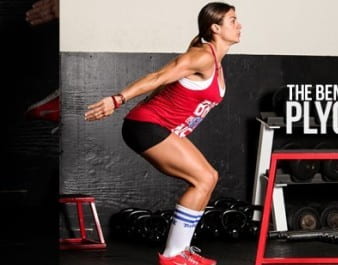
LJ & Sprinting: P L Y O M E T R I C S
Plyometrics have been used for many years in the Russian and eastern European training of track and field athletes (Chu & Panariello, 1989). Fred Wilt (1975) termed Plyometrics as a derivation from the Greek words plythein or plyo, meaning to increase and measure. Therefore, Plyometrics has thought to be used ‘to increase the measurement’ and is now typically used to increase sporting performance in throwing, velocity, jump height and sprint speed. However, it has shown to be important for pre-rehabilitation i.e. reduce the risk of future injury.
Mechanically, sprinting is not a complex skill whilst Long jump requires perfecting technique to optimise performance. Neurologically, both events require a complex sequence of firing by motor neurons to active the muscles to allow movement of the human lever system. A sprinters performance is determined by the force and speed of the muscles being able to contract and relax.
Plyometrics is a key attribute that can influence the neurological stimulus and overall enhance athletic performance. It can be broken down into two main features:
- Mechanical – Due to rapid stretch of a muscle (eccentric contraction) it will be shortly followed by a pause phase (Amortisation) the quicker this phase is, the more effective and powerful the plyometric movement is. This is immediately followed by shortening of the same muscle (concentric phase) whereby the muscle will immediately shorten, and the stored energy is released. Also known as the stretch-shortening cycle. (Komi, 2008).
- Neurophysiological – Stretch reflex: When a muscle spindle is stretched an impulse is immediately sent to the spinal cord and receives a message to contract the muscle. Therefore the spindle is stretched but protects the muscle spindle from being pulled forcefully or beyond a normal range. The synergistic muscles will further contract, preventing injury. At the same time, stretch reflex is activated and a signal is sent to the antagonist muscles to relax. Without this inhibitory action, both muscles would end up contracting simultaneously. This is a constant process, whereby the body is always under push and pull forces (Brodal, 2016).
Davies et al. (2015) Rapid voluntary contractions of skeletal muscle are achieved through the recruitment of motor neuron units. Type I fibres also known as slow twitch fibers are recruited at sub‐maximal intensity efforts, and then as the intensity increases, the fast twitch (FT) IIa fibers are recruited between 30 to 80 percent of maximal intensity. Furthermore, activities such as Plyometrics, which are trained at much higher intensity efforts (70‐80 percent) the fast twitch IIa fibres can be established to IIb fibres. Thus, plyometrics need to be performed with high intensity efforts, above 80 percent, to recruit the fast twitch fibers that are crucial to power development.
In the below video, I have highlighted some key Plyometrics drills that are sufficient for a long jumper and sprinter. There are various adaptations you can apply to these particular drills, such as non slip multi height boxes and steps. Boxes will help the athlete to think more about correct landing mechanics whilst steps will encourage the athlete to use power for horizontal and vertical acceleration/force to clear the steps.
This video has been aimed at an Intermediate level athlete, during their pre-season phase. I would increase the volume and decrease the volume during off-season, as this is a good phase to focus on the basics. Whilst during the season, you would dramatically lower the volume and intensity, as it is important to reduce the risk of injury during this particular period.
You must take care of the athletes safety! Take into consideration: Equipment safety, Efficient space, Gender differences, Type of sport, Athletes body mass to risk of injury, Biological Age, Warm-up, Uni-lateral vs Bi-lateral and Appropriate progressions.
MONITORING VOLUME
Chu (1998) proposed a guidance for the type of individual, you may train and how the time of the macro-cycle may affect volume.
Number of foot contacts per session throughout the season.
| Status | Off-season | Pre-season | In-season |
| Beginner | 60-100 | 100-250 | depends on sport |
| Intermediate | 100-150 | 150-300 | depends on sport |
| Advanced | 120-200 | 150-450 | depends on sport |
Chelly et al. (2015) found that a short-term Plyometrics program completed in-season, 3 times a week showed a significant increase in jump, sprinting performance and thigh muscle volume in young male athletes. All of which are important components of enhancing athletic performance.
References
Brodal, P. (2016) The Central Nervous System. (5th. ed). Oxford University Press: USA.
Chelly, M. S., Hermassi, S. and Shephard, R. J. (2015) Effects of In-Season Short-term Plyometric Training Program on Sprint and Jump Performance of Young Male Track Athletes. Journal of Strength & Conditioning Research. Vol. 29, No. 8: 2128-2136.
Chu, D. D. (1998) Jumping into plyometrics. (2nd. ed) Human Kinetics: US.
Chu, D. A. and Panariello, R. A. (1989) Jumping into plyometrics: Sport specific plyometrics: Baseball pitching. Nat Strength & Cond Assn J. Vol. 11: 81‐85.
Davies, G., Riemann, L. B. and Manske R. (2015) CURRENT CONCEPTS OF PLYOMETRIC EXERCISE. Int Journal of Sports Physical Therapy. Vol. 10, No. 6: 760-786.
Komi, P. (2008) The Encyclopaedia of Sports Medicine: An IOC Medical Commission Publication. (2nd. ed). Blackwell Science Ltd: Oxford.